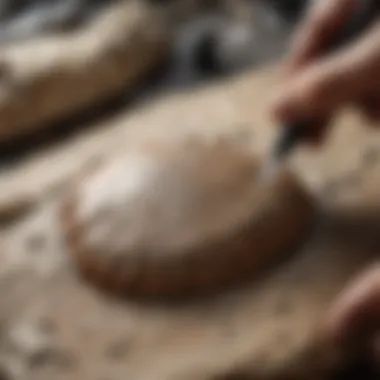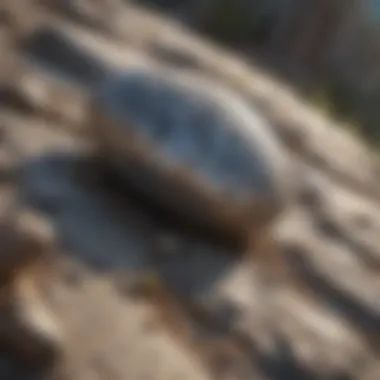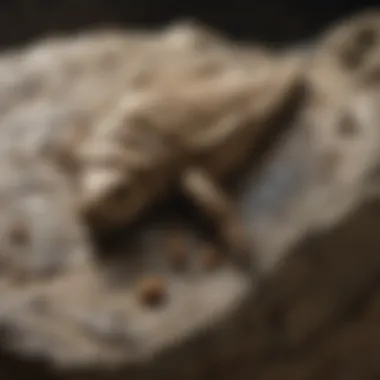Essential Guide to Utilizing Waterproof Glue for Rocks


Rock and Fossil Identification
As a dedicated rock and fossil collector, it is crucial to have a solid foundation in rock and fossil identification. Understanding the various types of rocks and fossils, ranging from sedimentary to igneous, as well as the distinct characteristics to look for, such as color, texture, and patterns, can greatly enhance your collection. Utilizing tools like magnifying glasses, hardness picks, and scratch plates further aids in discerning the geological composition of your specimens.
Collecting Tips and Techniques
Moving beyond identification, honing best practices for collecting rocks and fossils is paramount. This includes scouting prime collecting sites, which might involve researching geological maps or joining local rockhounding clubs for insider tips. Knowing how to safely extract specimens without causing damage ensures the integrity of your collection remains intact, whether you're chiseling away at sedimentary layers or delicately excavating fossils.
Preservation and Display
Once you have your prized rocks and fossils in hand, mastering preservation techniques becomes essential. From using waterproof glue to reinforce fragile sections to choosing the right storage methods to prevent decay or deterioration, safeguarding your treasures for future generations requires attention to detail. Furthermore, exploring creative display ideas, such as custom-made shadow boxes or rotating LED pedestals, can elevate the aesthetic appeal of your collection while highlighting their unique features.
Geological Insights
Delving into the geological insights behind rocks and fossils adds a layer of depth to your collecting journey. Understanding how these formations reflect past geological processes, from volcanic eruptions to sediment deposition, provides a context that enriches their historical significance. Exploring notable discoveries in the field, whether it's uncovering rare minerals or tracing the evolution of ancient life forms, expands your knowledge base and fuels a deeper appreciation for the wonders of the earth.
Introduction
Waterproof glue plays a pivotal role in the meticulous world of rock collecting, offering enthusiasts a reliable and durable solution to preserving their precious geological specimens. Understanding the nuances of using waterproof glue is essential for maintaining the integrity and aesthetics of rock collections. This article serves as a comprehensive guide, unveiling the significance of selecting the right adhesive for rock enthusiasts.
Understanding the Significance of Waterproof Glue in Rock Collecting
The Fragile Nature of Rock Specimens
The Fragile Nature of Rock Specimens underscores the delicate composition of rocks, emphasizing the need for a secure and lasting bond. As rocks vary in texture and porosity, utilizing the correct adhesive is crucial to ensure long-term stability. Waterproof glue acts as a protective shield against potential damage or breakage, safeguarding valuable rock specimens for years to come.
The Perils of Using Incorrect Adhesives
Choosing the wrong adhesive for rock collecting can have detrimental effects on the structural integrity of specimens. Incorrect adhesives may not bond effectively with rocks, leading to weak connections that are susceptible to environmental factors. Waterproof glue offers a reliable solution by creating a strong and lasting adhesion, mitigating the risks associated with using improper adhesives.
Overview of Waterproof Glue Types
Cyanoacrylate (Super Glue)
Cyanoacrylate, commonly known as Super Glue, is renowned for its rapid bonding properties and versatility. Ideal for securing small rock fragments or repairing minor damages, Super Glue offers a quick and durable solution for rock collectors seeking efficient adhesion.
Epoxy Resin
Epoxy Resin emerges as a popular choice for its exceptional strength and adhesive properties. Suitable for bonding a wide range of rock types, Epoxy Resin provides a reliable and resilient bond that withstands varying environmental conditions, ensuring the longevity of rock collections.


Polyurethane Adhesives
Polyurethane Adhesives offer flexibility and durability, making them ideal for bonding rocks with distinct textures and compositions. With excellent water resistance and durability, Polyurethane Adhesives provide a versatile solution for securing rocks in outdoor or indoor displays.
Factors to Consider Before Applying Waterproof Glue
Porosity and Texture of the Rocks
The porosity and texture of rocks influence the selection of waterproof glue, as highly porous rocks require adhesives that penetrate effectively to form a strong bond. Understanding the composition of rocks enables collectors to choose the appropriate adhesive that adheres securely to the surface, enhancing the overall stability of rock assemblies.
Exposure to Water and Sunlight
Considering the exposure of rock displays to water and sunlight is critical in selecting waterproof glue. Adhesives with high water resistance and UV protection properties are recommended for rocks situated in outdoor settings to prevent deterioration from environmental elements. By factoring in these aspects, collectors can ensure the longevity and durability of their glued rock collections.
Choosing the Right Waterproof Glue
In the vast world of rock and fossil collecting, the selection of the appropriate waterproof glue plays a pivotal role in ensuring the longevity and preservation of geological specimens. The meticulous process of choosing the right waterproof glue goes beyond simple adhesion; it involves factors that directly impact the integrity of the collection. As dedicated rock enthusiasts seek to maintain their prized possessions with precision and care, the significance of selecting an ideal adhesive cannot be overstated.
Key Considerations for Selecting the Ideal Adhesive
Durability and Longevity
When delving into the domain of waterproof glues for rocks, durability and longevity emerge as quintessential elements to safeguard the structural cohesion of specimens. The innate ability of the adhesive to withstand varying environmental conditions, including moisture exposure and temperature fluctuations, ensures that the glued rocks retain their original state over time. The durability and longevity of the chosen glue directly contribute to the overall preservation goals, offering rock collectors a reliable solution for maintaining the pristine condition of their collections. Furthermore, the exceptional resilience of these adhesives underscores their popularity among enthusiasts who seek steadfast protection for their geological treasures.
Transparency and Finish
Transparency and finish serve as essential characteristics to consider when selecting the ideal adhesive for rock applications. The clear and smooth nature of the glue not only provides a visually appealing aesthetic but also ensures that the adhesive seamlessly blends with the rocks without compromising their natural beauty. This transparent quality enhances the overall appearance of the bonded rocks, granting collectors the advantage of showcasing their specimens without any unsightly residue or discoloration. The exceptional finish achieved through the use of transparent glues reinforces their position as a favored choice for those keen on meticulous presentation and preservation of their rock collections.
Flexibility for Natural Movements
Flexibility for natural movements stands out as a key aspect in adhesive selection for rocks due to the dynamic nature of geological formations. The ability of the glue to adapt to the subtle shifts and movements of rocks over time is fundamental in maintaining the structural integrity of the collection. By accommodating natural movements without compromising adhesion strength, flexible glues offer a reliable solution for preserving rocks in their original positions while accounting for any potential adjustments. This unique feature not only ensures the stability of the bonded rocks but also mitigates the risk of damage that may arise from external forces or geological changes, making flexible adhesives a prudent choice for rock enthusiasts.
Application Techniques for Waterproof Glue
In the realm of rock and fossil collecting, mastering the application techniques for waterproof glue is of paramount importance. This section delves into the intricate process of seamlessly bonding rocks together, ensuring their longevity and preservation. By understanding the nuances of applying waterproof glue, enthusiasts can enhance the durability and aesthetics of their geological treasures significantly. The meticulous application of these techniques sets the foundation for a secure and enduring bond between rock specimens, allowing collectors to showcase their pieces with confidence and pride.
Step-by-Step Guide to Properly Gluing Rocks
Surface Preparation and Cleaning
Surface preparation and cleaning are fundamental steps in the successful application of waterproof glue. Thorough cleaning of the rock surfaces removes any impurities or residues that may hinder the adhesive's efficacy. This meticulous process ensures optimal adhesion by creating a pristine bonding surface free from contaminants. The key characteristic of surface preparation and cleaning lies in its ability to provide a smooth and pristine surface, facilitating the adhesive's penetration and adhesion strength. Its advantage in this context is undeniable, as it allows for a reliable bond that withstands the test of time.


Applying the Adhesive with Precision
Applying the adhesive with precision is a critical aspect of the gluing process, as it determines the strength and durability of the bond. The precise application of the waterproof glue ensures even coverage across the bonding surfaces, minimizing the risk of weak spots or inconsistencies. This methodical approach guarantees maximum adhesion and structural integrity, avoiding potential deformities or detachment over time. The unique feature of precise adhesive application lies in its ability to create a uniform and robust bond that enhances the overall visual appeal and structural stability of the rocks. Its advantage in this article is evident, as it paves the way for flawless and enduring connections between rock specimens.
Drying and Curing Times
Understanding the drying and curing times of the waterproof glue is imperative for successful rock bonding. Proper adherence to the specified drying and curing durations is essential to allow the adhesive to set and create a strong bond. Rushing this process can compromise the integrity of the bond, leading to potential instability or failure in the long run. The key characteristic of optimal drying and curing times is their role in ensuring a thorough and secure bond between the rocks. Adhering to these timelines guarantees that the adhesive reaches its maximum strength, providing a reliable and durable connection that can withstand various environmental conditions. While the patience required for adequate drying and curing times may test collectors' eagerness, the payoff in terms of reinforced bond strength and longevity is certainly worth the wait.
Special Considerations for Different Rock Types
In the realm of rock collection and preservation, special considerations for different rock types hold paramount importance. Understanding the diverse nature of sedimentary, metamorphic, and igneous rocks is pivotal in choosing the appropriate waterproof glue for effective adhesion and long-lasting results. Incorporating these considerations ensures the durability and longevity of assembled rock specimens, elevating the overall craftsmanship of collection maintenance.
Sedimentary Rocks
Challenges in Adhesion
Challenges in adhesion within sedimentary rocks pose a unique set of considerations for rock collectors. The fragile nature of sedimentary rocks, characterized by their layered formation over time, presents difficulties in achieving strong and lasting bonds. The key challenge lies in ensuring that the adhesive penetrates the porous structure of sedimentary rocks effectively, providing a secure attachment without causing damage. Selecting the right waterproof glue that offers excellent bonding strength while not compromising the integrity of the rock surface is crucial in overcoming these challenges.
Ideal Glue Selection
Choosing the ideal glue for sedimentary rocks revolves around factors such as compatibility with porous surfaces, flexibility to accommodate natural movements, and resistance to environmental elements. The selected adhesive should exhibit high adhesion properties to integrate seamlessly with the rock surface, ensuring a sturdy bond capable of withstanding long-term stress. Moreover, opting for a specialized glue formulated for sedimentary rocks enhances adhesion strength and minimizes the risk of detachment, preserving the aesthetic appeal and structural integrity of the assembled specimens.
Metamorphic Rocks
Adhesive Compatibility
Achieving optimal adhesive compatibility with metamorphic rocks is essential for maintaining the intrinsic beauty and structural stability of these geological formations. Metamorphic rocks undergo intense heat and pressure, resulting in a compact and often intricate composition that demands a glue capable of adhering to varied textures and surfaces. The adhesive selected must possess excellent compatibility with the unique structure of metamorphic rocks, ensuring a secure bond that withstands environmental factors and minimizes the risk of detachment over time.
Ensuring Long-Term Stability
Ensuring long-term stability in adhesive applications to metamorphic rocks involves selecting a glue that offers superior durability and resistance to external stressors. The chosen adhesive should provide a strong and flexible bond that accommodates the movements and mineral composition of metamorphic rocks, preventing cracks or detachment. Emphasizing long-term stability through proper adhesive selection and application techniques safeguards the integrity of the rock specimens, enabling collectors to showcase their prized metamorphic formations with confidence.
Igneous Rocks
Heat Resistance Requirements
The heat resistance requirements associated with igneous rocks necessitate the use of specialized adhesives capable of withstanding high temperatures without compromising bond strength. Igneous rocks, formed from volcanic activity, exhibit rugged textures and may be exposed to elevated temperatures, demanding a glue that can endure such extreme conditions. Selecting a waterproof adhesive with inherent heat resistance properties ensures that bonded igneous rocks maintain their structural integrity and aesthetic appeal, even in environments with fluctuating temperatures.
Preservation Techniques


Preservation techniques for igneous rocks focus on enhancing their longevity and visual appeal through proper adhesive applications. The chosen glue should not only provide a secure bond but also offer protection against moisture, UV exposure, and other environmental factors that can deteriorate the rock surface over time. Implementing preservation techniques that involve selecting waterproof glues designed specifically for igneous rocks ensures that these geological marvels retain their original allure and structural coherence for years to come.
Ensuring Longevity and Durability
Ensuring longevity and durability of rock collections is paramount in the realm of rock and fossil collecting. The delicate nature of rocks and fossils requires meticulous care to maintain their integrity over time. By focusing on ensuring longevity and durability, collectors can protect their geological treasures from environmental factors and preserve them for future generations.
One key element in ensuring longevity and durability is the proper storage of glued rock collections. Proper storage conditions play a crucial role in preventing damage to the adhesive bonds and maintaining the overall quality of the rocks. Storing rocks in a cool, dry place away from direct sunlight and moisture is essential to prevent deterioration and ensure the longevity of the glue bonds. This meticulous attention to storage conditions is a fundamental aspect of preservation efforts for rock collectors, as it directly impacts the stability and durability of the glued specimens.
Periodic inspections and repairs are another essential component of maintaining longevity and durability in glued rock collections. Regularly inspecting the glued rocks for any signs of wear, damage, or loosening of adhesive bonds allows collectors to address any issues promptly. By conducting routine inspections and performing necessary repairs, collectors can prolong the lifespan of their rock collections and prevent further damage. This proactive approach to maintenance ensures that the glued rocks remain intact and visually appealing, enhancing their longevity and durability.
Maintenance Tips for Glued Rock Collections
Proper Storage Conditions
Proper storage conditions are crucial for preserving the longevity and durability of glued rock collections. Storing rocks in a cool, dry environment away from direct sunlight and moisture ensures that the adhesive bonds remain strong and prevents deterioration. The consistency of temperature and humidity plays a vital role in maintaining the structural integrity of the rocks, prolonging their lifespan and overall quality. Collectors should prioritize proper storage conditions to safeguard their geological treasures for years to come.
Periodic Inspections and Repairs
Periodic inspections and repairs are essential maintenance practices for glued rock collections. Regularly inspecting the glued rocks for any signs of wear, damage, or loosening of adhesive bonds allows collectors to identify and address issues early on. By conducting routine inspections and promptly repairing any damage, collectors can ensure the longevity and durability of their rock collections. This proactive maintenance approach enhances the overall condition of the specimens and minimizes the risk of further deterioration, preserving the beauty and structural integrity of the glued rocks.
Enhancing Protection Against Environmental Factors
Protecting glued rock collections from environmental factors is paramount to maintaining their longevity and durability. Factors such as exposure to UV rays and moisture can degrade adhesive bonds and affect the appearance of the rocks over time. By implementing UV protection measures and using waterproof sealants, collectors can safeguard their collections from these harmful effects and ensure their longevity.
UV Protection Measures
UV protection measures shield glued rock collections from the damaging effects of UV rays, which can cause adhesive bonds to weaken and rocks to fade or discolor. By applying UV-resistant coatings or keeping the rocks in UV-protected cases, collectors can preserve the integrity and appearance of their specimens. These protective measures enhance the longevity and durability of glued rock collections, ensuring that they maintain their visual appeal and structural strength for years to come.
Waterproof Sealants
Waterproof sealants provide an additional layer of protection for glued rock collections, preventing moisture damage and ensuring the longevity of the adhesive bonds. By applying waterproof sealants to the surfaces of the rocks, collectors can create a barrier against water intrusion and maintain the structural integrity of the specimens. These sealants offer enhanced protection against environmental factors, helping to prolong the lifespan of glued rocks and preserve their beauty and quality.
Conclusion
In this comprehensive guide exploring the world of waterproof glue for rocks, it becomes evident that the art of preserving geological treasures is not only a hobby but a practice that demands precision and care. The significance of properly gluing rocks transcends mere adherence; it symbolizes a deep respect for the natural world and a commitment to maintaining the integrity of geological specimens. As rock and fossil collectors navigate the intricate process of selecting the right adhesive, understanding its application techniques and considering the specific needs of various rock types, the conclusion serves as a testament to their dedication to this craft.
Craftsmanship in collection maintenance plays a pivotal role in ensuring the longevity and durability of rock collections. By meticulously applying waterproof glue and adhering to best practices in rock maintenance, collectors showcase their attention to detail and commitment to preserving these geological treasures for generations to come. The meticulous care taken in selecting the ideal adhesive for each rock type reflects the delicate balance between artistry and practicality, shaping the narrative of rock and fossil collection as a harmonious blend of science and artistry.
The Art of Preserving Geological Treasures
Significance of Properly Gluing Rocks
In the realm of rock collecting, the proper gluing of rocks holds a significant position as it determines the longevity and visual appeal of geological artifacts. The Significance of Properly Gluing Rocks lies in its ability to bond rocks seamlessly without altering their natural aesthetics. This crucial aspect ensures that collectors can showcase their specimens without compromising their inherent beauty. A beneficial choice for this article, the Significance of Properly Gluing Rocks underscores the importance of using high-quality waterproof glue to maintain the integrity of rock collections over time.
Craftsmanship in Collection Maintenance
Craftsmanship in Collection Maintenance represents the meticulous approach that collectors take to preserve and display their rock specimens. This key characteristic involves attention to detail, precision in application, and a deep appreciation for the inherent value of geological treasures. By prioritizing craftsmanship in collection maintenance, rock and fossil collectors can elevate their hobby to an art form, showcasing not only the rocks themselves but also the dedication and skill invested in their preservation. The advantages of emphasizing craftsmanship in collection maintenance include enhanced visual appeal, increased durability, and a deeper connection to the geological wonders that these specimens represent.







